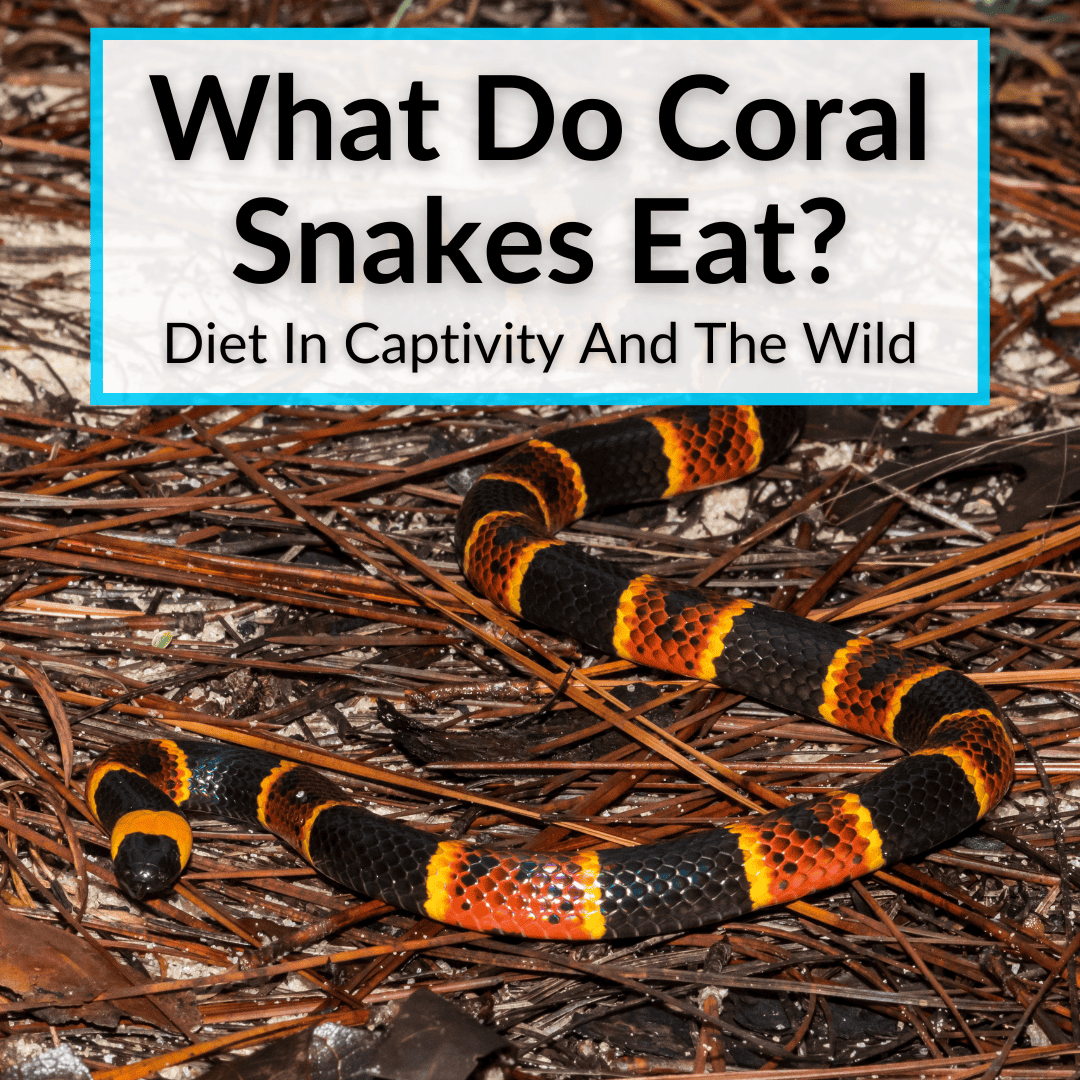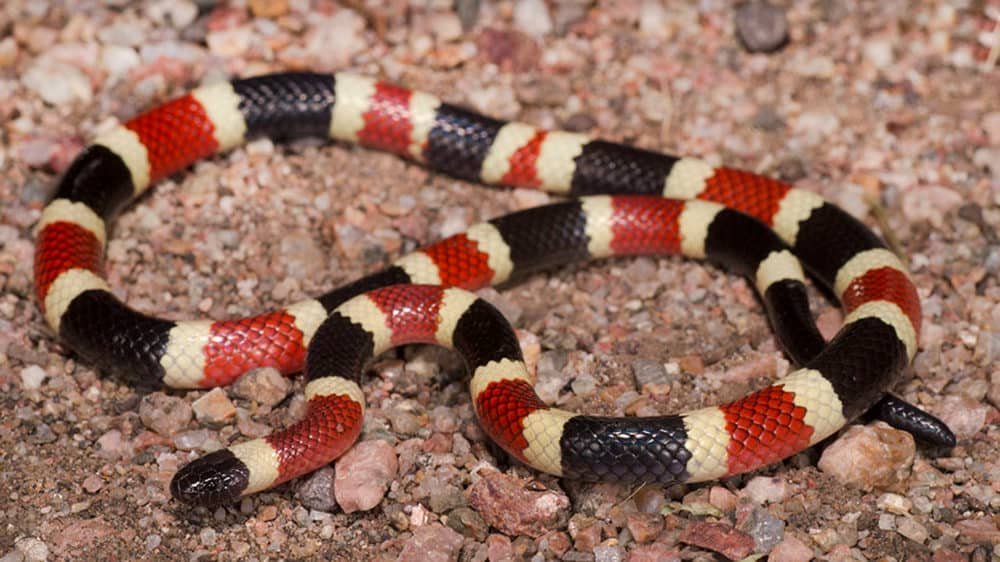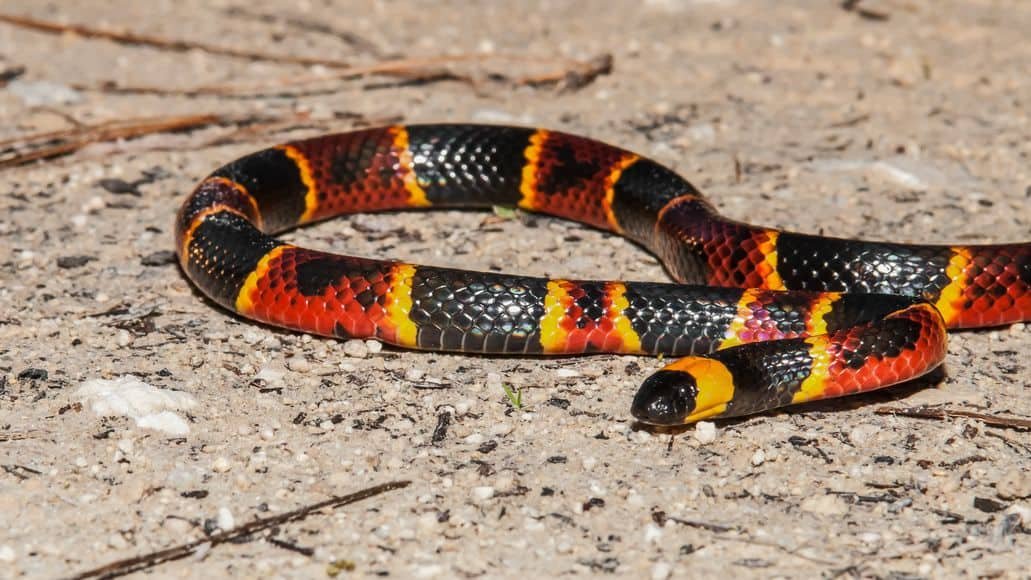
But they are also deadly.
Especially to the animals they eat.
And they only eat other animals. No vegans or vegetarians here.
But what do coral snakes eat exactly. Which animals do they hunt and kill?
Keep reading to find out. We will cover everything you need to know about the coral snake diet.
Table of Contents
What Do Coral Snakes Eat?
In the wild, coral snakes eat frogs, salamanders, toads, skinks, insects, lizards, mice, birds, and other smaller snakes, including coral snakes. In captivity, you can feed your pet coral snake thawed frozen mice.
In nature, these snakes hide under leaves and surprise their prey. Coral snakes use their tongues to smell for food. Once a coral snake bites its prey, it doesn’t let go until the animal is dead.
Even though they catch live prey in the wild, it is best not to feed live prey to your pet coral snake. The prey could injure your snake.
Coral Snake Food: The Complete List

As mentioned, wild coral snakes eat lizards or skinks, smaller snakes (including other coral snakes), rodents like rats and mice, small birds and their eggs, and amphibians like frogs, salamanders, and toads.
There are three known species of coral snakes and all three varieties eat the same kind of prey. All three varieties are fossorial, meaning they hide under leaves and ambush their prey.
This means they aren’t too picky about what they eat. They will eat anything small that wanders close to their hiding places. Once they catch hold of their prey, they bite and do not let go until their prey stops struggling. They then eat the prey.
In their natural habitats, coral snakes usually come across small lizards or skinks, insects, small birds, and rodents. One type of coral snake is also aquatic and eats frogs, salamanders, and toads.
Coral snakes are also snakes with cannibalistic tendencies and eat their own kind. They can also eat other non-venomous and venomous snakes that are smaller than them.
Here is a summary of the foods wild coral snakes eat:
- Insects
- Small birds
- Frogs
- Toads
- Salamanders
- Lizards
- Skinks
- Other coral snakes
- Other venomous or non-venomous snakes
Coral Snake Diet In Captivity

Your vet can prescribe the best diet for your pet coral snake. In general, you can feed your pet the following pre-killed or frozen food.
- Rodents
- Rabbits
- Small birds
- Frogs
- Toads
- Slugs
- Fish
- Small mice
- Rats
- Gerbils
- Hamsters
What Should You Not Feed A Coral Snake?
Your pet coral snake will do well on a diet of thawed frozen rats or mice. Never feed an incompletely thawed rat to your pet. Its insides may still be frozen and that could drastically bring your coral snake’s body temperature down.
Remember: snakes are cold-blooded and cannot regulate their body temperatures.
Never feed live food to your coral snake. The prey is bound to be frightened and might strike at or attack your coral snake. This could seriously injure your snake.
Avoid feeding insects like fireflies, ticks, scorpions, and spiders to your pet coral snake. Some of these insects are venomous and could harm your pet snake.
Is The Coral Snake Venomous?

Yes, coral snakes are venomous. They belong to a group of venomous snakes called Elapidae. This family also includes the deadly cobras, mambas, and sea snakes.
Coral snakes inject nerve-attacking venom into their victim’s bodies using their fangs. These snakes have fangs on either side of their upper jaws. The fangs are longer than the other teeth.
However, a coral snake’s fangs are much smaller than the fangs of other venomous snakes. Moreover, coral snakes’ fangs are fixed in place rather than being folded against the roof of the mouth, like the fangs of rattlesnakes are.
How Venomous Is The Coral Snake?
Coral snakes are highly venomous. Their venom is among the most potent in all of north America. However, they are not as dangerous as many other snakes with less potent venom.
The reason for that is their docile nature and their inefficient venom delivery system. Because they are not aggressive snakes, bites are fairly rare. And when they do bite, their small fangs are not able to deliver venom effectively.
The fangs inject neurotoxins into their victim’s blood. These neurotoxins rapidly spread through the blood and throughout the victim’s body, where they attack the nerves. The venom paralyzes the victim until the heart and lungs stop working. This is how coral snakes kill and eat their prey.
But because the fangs are so small, they are not able to deliver venom very deeply. They also don’t deliver much at once, so they need to keep chewing on their prey to deliver more. It works well for small animals, but not so well for something as large as us humans.
Can Coral Snake Bites Kill Humans?

Coral snake bites have resulted in very few human victims. First of all, these snakes are quite shy and they prefer hiding or slithering away if they come across humans.
Bites only occur when humans try to handle the snakes. Or when they accidentally step on one.
Second, coral snakes have to chew on our skin and take a large chunk of it to inject enough venom to cause death. Given their small mouths and small-sized fangs, this is nearly impossible.
Third, coral snake antivenin is also available. Consequently, there have been no human deaths reported due to coral snake bites since the antivenin’s release in 1967.
To date, fewer than 1% of all snake bites in the United States can be attributed to coral snakes.
Symptoms Of Coral Snake Bites In Humans
If a coral snake does bite a human, there may be no pain or swelling for a few hours. However, it is important to administer antivenom.
Failure to do so could cause slurred speech, double vision, muscle paralysis, and respiratory or cardiac failure.
Can You Survive A Coral Snake’s Bite?

Yes, humans, pet dogs, and cats could all survive a coral snake’s bite, provided they quickly get the antivenin.
Time is of the essence here, since the snake’s neurotoxin can create a barrier that prevents the nervous system from sending messages to the brain.
This can cause muscular paralysis, which can eventually cause the heart to stop and other organs to fail.
What Kills Coral Snakes?
Coral snakes have many enemies. Their number one enemy is the coral snake itself, since these snakes show cannibalistic tendencies. A small coral snake can easily fall prey to a larger coral snake.
Birds like falcons, serpent eagles, brown snake eagles, owls, vultures, and hawks are also known to eat coral snakes. These birds have sharp beaks and talons and can wield powerful kicks that easily crush the venomous snake.
Some ground squirrels have also developed resistance to the venom of coral snakes. They are even smart enough to rub their bodies against the shed skin of molting snakes.
This fools the coral snakes. They are unable to ‘smell’ the squirrel and get eaten instead.
Bullfrogs are other predators of coral snakes. They eat snakes, other bullfrogs, and even human flesh. Some bullfrog species inflate their bodies while attacking their victims.

Some spiders, like black widow spiders, are also able to kill and eat coral snakes. Their webs trap the snake and the small spider can easily fight and eat the coral snake, which is nearly 30 times larger in size.
Coral Snake Diet: Final Thoughts
Coral snakes are ambush hunters. As such, they are opportunistic. They will basically eat anything that comes their way, as long as it is the right size and they are able to catch it.
Because of this, their diet is varied and consist of whatever small animals share their habitat.This includes frogs, salamanders, toads, skinks, insects, lizards, mice, birds, other smaller snakes, and even other coral snakes. If you have a pet coral snake, you can just feed it thawed frozen mice, to keep things simple.
Leave a Reply